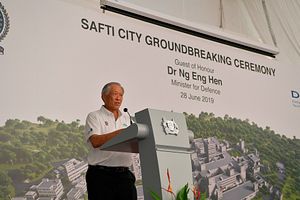Last week, Singapore held a groundbreaking ceremony for the development of a new military training facility. The development spotlighted the country’s ongoing efforts to reinforce its local training grounds as part of its ongoing defense modernization.
As I have noted before in these pages, one of the challenges for land-scarce Singapore has been how to conduct training for its military. And while Singapore continues to maintain partnerships with other countries to conduct overseas training, defense officials have repeatedly emphasized the need to further develop training grounds within the country as well.
Among the initiatives in this vein is the upgrading of the Singapore Armed Forces’ (SAF) western SAFTI training area. Plans have been in the works for years between the Singapore Army and the Defense Science and Technology Agency (DSTA) to revamp this into a new “SAFTI City,” which Defense Minister Ng Eng Hen had told parliament back in 2017 would span about 88 hectares, featuring a range of terrain, state-of-the-art training simulation technologies, physical facilities, and a one-stop hub for National Service related services costing about 900 million Singapore dollars (about $664 million). This is part of a broader effort to forge a Next Generation Singapore Armed Forces (SAF).
On June 28, this development was in the headlines again with a groundbreaking ceremony held for SAFTI City. Singapore’s Defense Minister Ng Eng Hen, who was accompanied by a range of other senior officials and personnel, officiated a ceremony that officially marked another step forward for the development of the new facility.
The groundbreaking ceremony comprised of a series of interactions. Per Singapore’s defense ministry (MINDEF), Ng participated in the symbolic sod turning and was also introduced to key features of SAFTI City through a virtual reality (VR) walkthrough together with other officials and personnel as well.
In his speech at the engagement, Ng described the importance of SAFTI City as being part of an effort to build the most advanced training facilities at home and abroad that were more in line with the face of the likely battlefield for a new generation of Singaporeans – with engagements such as peacekeeping, humanitarian assistance and disaster relief, counterterrorism and homeland security operations in built-up areas and high-density precincts rather than traditional jungle operations. He also mentioned other related efforts as well, including Singapore’s efforts to build new facilities in Queensland, Australia.
Per MINDEF, when complete, SAFTI City is expected to feature several urban features to replicate Singapore’s streetscapes and residential areas –including an integrated Transport Hub, dense building clusters, and multiple road networks – and will also be a smart facility including battle effects simulators, smart targets, and data analytics and video monitoring to evaluate the training outcome of soldiers.
To be sure, it is still early days in the development of SAFTI City. Singapore officials have said that official construction is expected to commence soon, with the first phase with the training urban city center completed progressively in 2023, and the second phase seeing the building of a training industrial complex. Nonetheless, given its importance for Singapore’s defense modernization, it will remain something to watch closely in the years that follow.
































